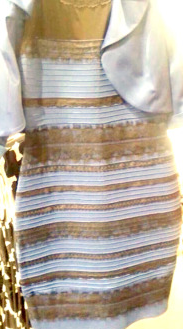What is the White and Gold Dress Mean
Our brains are the most amazing supercomputers that exist. They are constantly computing information to help us perceive the world. Yes, the eyes, ears, mouth, nose, and skin are required to take physical information such as light waves, sound waves, chemicals, and touch into neural signals so that we can sense them. However, it is the brain that constructs our perception of reality for us. Differences exist between individuals in sensory and perceptual processing, as well. This means that we may not all be experiencing the same reality – as is the case with the now famous blue and black or white and gold dress.
Half the people on social media see this dress as blue and black and the other half see it as yellow and gold. Why the disparity across people? How can we be perceiving such different colors in the same object? This debate is reminiscent of themes from the movie The Matrix, in which the protagonist Neo realizes that our brains are the source of all of our perceptions and, essentially, of our individual reality. Yes, a dress can spur an existentialist debate! Another related movie is Inception, another movie about altered perceptions and beliefs about reality.
All related philosophical and epistemological debates aside, let's get down to the science of how and why the general public can't agree on the color of this fashionable dress. There is an entire subfield of psychology called sensation and perception, within which vision scientists vastly outnumber the researchers who devote their studies to the other senses.
When we view an object, the light source (illuminant) reflects off of it and the light waves that reach our eye are processed by photoreceptors in the retina. These photoreceptors send information to our brain, which then constructs our perception of the object.
Visual scientists have long known that the brain processes incoming visual information in a way that yields perceptual constancy. In vision, perceptual constancy is the ability to see objects as not changing in shape, size, location, or color despite changes that may occur in viewing angle, distance, and lighting. This helps us to make sense of the world. Could you imagine if our visual perception of the world were to constantly change due minor variations in viewing angle and/or light source? It would lead to perceptual confusion and chaos!
For example, fluorescent lights give off a higher percentage of yellow light than what is found in the color spectrum of daylight. However, we don't see everybody and all things as yellow-tinged when we are indoors under fluorescent lighting conditions. The brain works to subtract out the extra yellow, in other words to compensate for the colors present in the light rays of the illuminant (lighting) in order to yield our ultimate perception. Our visual system discounts the information about the light source so that we process the colors of the actual object being viewed.
This appears to be exactly what may be happening in the case of the famous color ambiguous dress! The dress is actually blue and black. However, when some of us see the dress and our brain assumes that we are looking at it in daylight conditions and makes some adjustments to account for the color spectrum of the light source. For about half of us, the brain discounts the blue side of the light source, subtracting out the blue from the actual color of the dress so that we perceive the dress as white and gold. For the rest of us, the brain discounts the gold spectrum of the light, yielding a totally different perception of the dress as that of a blue and black dress.
Wild! And all the result of an automatic computation that the visual brain makes that usually helps us perceive the world consistently and accurately. Share this blog post with a friend and put them to the test; ask them which colors THEY see in the ambiguous dress below… Is their reality the same as yours?

Source: Swiked
Source: https://www.psychologytoday.com/us/blog/have-you-ever-wondered/201503/the-blueblack-whitegold-dress-questioning-reality
0 Response to "What is the White and Gold Dress Mean"
Post a Comment